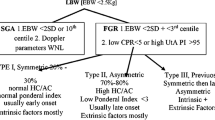Abstract
Being born small for gestational age (SGA) is classified as being born with a fetal weight or an abdominal circumference below the 10th percentile for gestational age. In the past, a variety of cutoffs have been used, adding some uncertainty to the value of individual definitions of SGA. Of note, the diagnosis of SGA does not allow a distinction between infants who are constitutionally small, growth-restricted and small, or growth-restricted but not small. In general, up to 70 % of infants are considered constitutionally small due to maternal ethnicity, parity, body mass index, and female gender, and thus are not at risk of increased morbidity and mortality; it is important to realize that fetal size is not equivalent to fetal growth. Therefore, a single fetal biometry will not be able to reliably distinguish between SGA and intrauterine growth restriction (IUGR).
Access this chapter
Tax calculation will be finalised at checkout
Purchases are for personal use only
Preview
Unable to display preview. Download preview PDF.
Similar content being viewed by others
References
Chang TC, Robson SC, Boys RJ, Spencer JA. Prediction of the small for gestational age infant: which ultrasonic measurement is best? Obstet Gynecol. 1992;80:1030-1038.
Chard T, Costeloe K, Leaf A. Evidence of growth retardation in neonates of apparently normal weight. Eur J Obstet Gynecol Reprod Biol. 1992;45:59-62.
Ott WJ. The diagnosis of altered fetal growth. Obstet Gynecol Clin North Am. 1988;15:237-263.
Mongelli M, Wilcox M, Gardosi J. Estimating the date of confinement: ultrasonographic biometry versus certain menstrual dates. Am J Obstet Gynecol. 1996;174:278-281.
Neilson JP. Ultrasound for fetal assessment in early pregnancy. Cochrane Database Syst Rev. 2000;(02)CD000182.
Yang H, Kramer MS, Platt RW, et al. How does early ultrasound scan estimation of gestational age lead to higher rates of preterm birth? Am J Obstet Gynecol. 2002;186:433-437.
Mendez H. Introduction to the study of pre- and postnatal growth in humans: a review. Am J Med Genet. 1985;20:63-85.
Resnik R. Intrauterine growth restriction. Obstet Gynecol. 2002;99:490-496.
Guidetti DA, Divon MY, Braverman JJ, Langer O, Merkatz IR. Sonographic estimates of fetal weight in the intrauterine growth retardation population. Am J Perinatol. 1990;7:5-7.
Jouannic JM, Grange G, Goffinet F, Benachi A, Carbrol D. Validity of sonographic formulas for estimating fetal weight below 1,250 g: a series of 119 cases. Fetal Diagn Ther. 2001;16:254-258.
Mongelli M, Ek S, Tambyrajia R. Screening for fetal growth restriction: a mathematical model of the effect of time interval and ultrasound error. Obstet Gynecol. 1998;92:908-912.
Gardosi J, Francis A. A customized standard to assess fetal growth in a US population. Am J Obstet Gynecol. 2009;201:25.e1-7.
Chauhan SP, Gupta LM, Hendrix NW, Berghella V. Intrauterine growth restriction: comparison of American College of Obstetricians and Gynecologists practice bulletin with other national guidelines. Am J Obstet Gynecol. 2009;200:409.e1-e6.
Alfirevic Z, Neilson JP. Doppler ultrasonography in high-risk pregnancies: systematic review with meta-analysis. Am J Obstet Gynecol. 1995;172:1379-1387.
Bilardo CM, Wolf H, Stigter RH, et al. Relationship between monitoring parameters and perinatal outcome in severe, early intrauterine growth restriction. Ultrasound Obstet Gynecol. 2004;23:119-125.
Baschat AA. Doppler application in the delivery timing of the preterm growth-restricted fetus: another step in the right direction. Ultrasound Obstet Gynecol. 2004;23:111-118.
Baschat AA, Cosmi E, Bilardo CM, et al. Predictors of neonatal outcome in early-onset placental dysfunction. Obstet Gynecol. 2007;109:253-261.
Turan S, Turan OM, Berg C, et al. Computerized fetal heart rate analysis, Doppler ultrasound and biophysical profile score in the prediction of acid-base status of growth-restricted fetuses. Ultrasound Obstet Gynecol. 2007;30:750-756.
GRIT Study Group. A randomised trial of timed delivery for the compromised preterm fetus: short term outcomes and Bayesian interpretation. BJOG. 2003;110:27-32.
TRUFFLE multicentre group. TRial of Umbilical and Fetal FLow in Europe (TRUFFLE) Study. www.trufflestudy.org/truffle/index.htm. Accessed February 20, 2013.
Kennelly MM, Farah N, Turner MJ, Stuart B. Aortic isthmus Doppler velocimetry: role in assessment of preterm fetal growth restriction. Prenat Diagn. 2010;30:395-401.
Author information
Authors and Affiliations
Editor information
Editors and Affiliations
Rights and permissions
Copyright information
© 2013 Springer Healthcare
About this chapter
Cite this chapter
Zabransky, S. (2013). Obstetrical Aspects. In: Zabransky, S. (eds) Caring for Children Born Small for Gestational Age. Springer Healthcare, Tarporley. https://doi.org/10.1007/978-1-908517-90-6_7
Download citation
DOI: https://doi.org/10.1007/978-1-908517-90-6_7
Published:
Publisher Name: Springer Healthcare, Tarporley
Print ISBN: 978-1-908517-85-2
Online ISBN: 978-1-908517-90-6
eBook Packages: MedicineMedicine (R0)




